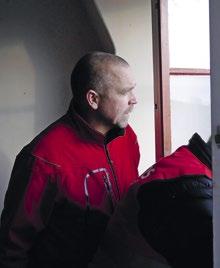
8 minute read
History of wenngarn
Wenngarn is strategically positioned and there are traces of settlers in the area going far back into prehistoric times. Nearby Wenngarn lies Garnsviken which, during this time, was one of the main routes to Uppsala from the Baltic Sea. The oldest written evidence (somewhere around 1160 AD) concerns a meddling between “Gere, Lord of Wenngarn” and the GreyFriars (Gråbröderna in swedish), an order of monks. This is a clear indication that there used to be an estate where Wenngarn now lies.
Shortly after this period a stone house was built, the first part of the castle that we see today. During the 16th century Wenngarn became a part of king Gustav Vasas estates. The kings tax administrator lived at Wenngarn which now, more and more, takes on the shape of a fortress.
Advertisement
One of Gustav Vasas sons, King Johan III, donated the castle to his nephew Magnus of Sachsen-Lauenburg. The castle then was passed on to Duke Gustav, his son, who modernised the castle in accordance to the ideals of the time and rebuilt it as a renaissance castle with spacious windows, tall gables and a wing adorned with a tower. He also immortalized his efforts by adding an inscription on one of the wings “The illustrious duke Gustav built this house 1591”.
The castle was returned to the crown and given to, in 1628, the general Franz Bernhard von Thurn, an immigrant from nowadays Czech Republic who was enrolled in the Swedish army. It is his son Heinrich who rents the castle to the De la Gardie family. The Wenngarn castle nearby Garnsviken by the Baltic Sea is mostly associated with the Era of Great Power and Magnus Gabriel De la Gardie who bought the estate in 1653.
In a portrait, painted by the Dutch Hendrick Münnichhoven, De la Gardies spouse - the Duchess of Pfalz Maria Eufrosyne stands one step higher, to illustrate her royal ancestry.

Magnus Gabriel De la Gardies different assignements.
The castle lies on top of a knoll with differences in levels between the yard and the gardens. The slopes were used for terrace cultivation. The central axis from the castle ascends through the valley to again re-emerge at a slope. The castle complex contrasts with the rural surroundings of forests, rolling hills, springs and the village buildings.
Commencing in 1661 De la Gardie starts a project to modernize and enlarge no less than three of his castles in Uppland, Jacobsdal (today Ulriksdal), Ekholmen and Wenngarn. To exploit the manual labour as efficiently as possible the expansion project ran simultaneously at all three castles, at times even more.
Wenngarn was adorned with a new appearance out of which we still can see parts of today. A complex was created around the castle itself with new wings and vast avenues that led to the castle. From the garden you were met by the view of an imposing park. The castle complex is similar to that of the Italian villa. The term villa in the context of a castle refers to a smaller castle planned for a more informal gathering and a park, a well-kept farm and the view creates the key components in the complex as much as the house it self. What we find at Wenngarn is as much a compromise between old and new that even at that time was completely innovative.
The park was the heart of the complex and had several different functions, both for utility and leisure. It was a so-called hybrid park that besides being beautiful and impressive also held useful plants and herbs used in housekeeping. The central point in the park consisted of a fountain.
At the farthermost part of the park a bower was set, a vantage point that underlined the length of the park. The interior was decorated with precious textiles, gyllenläder (a leather tapestry with painted ornaments) furniture and other prized artefacts – all according to the taste of the time. Not much of the inventory remains to this day.
The rooms were separated according to the acts in a theatre, they were meant to show off the castle in the most imposing manner possible. The role model for this system of room allotment was found on the continent, mainly France but also northern Europe and Germany. The count and countess’s living quarters were one flight of stairs above entry level with Magnus Gabriels room in the centre, within the vicinity of the chapel. Maria Eufrosynes room was situated in the newly built wing.
The manner in which the bedroom was used differs greatly from our modern customs. It was used as a parlour for the most prominent of guests. This demonstrated not only the couple’s superiority over the visitors but also their great confidence and trust in their guests and visitors. De la Gardies economical situation changed drastically during the reduction. The wealth of the aristocrats that had been provided throughout the latest decades was now retracted by kronan (The Crown – the government). Magnus Gabriel was accused of having misused the nations funds when he was förmyndare (custodian) and was brought to court.
The consequences brought upon Magnus Gabriel were severe, his estates were withdrawn and his position of power crushed. His wife, Maria Eufrosyne, who was the ruling king’s aunt, was allowed to keep Wenngarn for the rest of her life. Destitute and at his wife’s mercy the count spent his remaining years at Wenngarn.

Venngarn circa 1695. Copper plate by Willem Swidde in Suecia Antiqua et Hodierna.

“Geezers” – the patients The treatment of alcoholics didn’t get started properly until 1920. During the years between 1916-1920 it served as a foster home for unruly boys.


Wenngarns Institute for Alcoholics draped in winter clothing. Greetings by the Castle Wife. Cows in the now burnt down barn.
WENNGARN DURING THE 20TH CENTURY
When so the Swedish government commenced their search for a suitable place to establish a treatment for alcoholics, in 1913, they found Wenngarn to be a suitable site. But the treatment didn’t start properly until 1916 when the first patients arrived. In the terms of the contract from 1916-1956 it is said that “with treatment it is intended that the inmates at the institute should through manual labour and moral influence be put on to the straight and narrow path and return to a sober and proper life”, this appears from Johan Edmans thesis “The Dryer – forced labour of alcoholics in Sweden 1940-1981”.
Kerstin Hellerstedt tells of how Wenngarn was gradually formed into a society within a society. Farming, gardening and animal husbandry – all was conducted on the premises. A workshop (verkstadshus) was built with cobblers, tailoring, tinsmiths, carpentry, blacksmiths and painters. After the two superintendents Wijkmark and Göransson a Johan Lönnberg took over, father to (above-mentioned) Kerstin Hellerstedt. Life and times in the mid 1930’s as a young girl amongst the “geezers”, as the inmates were called, is described by her as a time filled with mischievous activity together with the other children at the courtyard. The initial schooling took place in the Castle School. There were four children attending in the first grade and another four in the second. At Sundays a sermon was held in the chapel that, by the way, was an excellent place to play hide and seek.
She recalls of culling of turnips and weeding, parties, luciatåg (a yuletide celebration of the saint Lucia), football and theatrical plays. A tragic event occurred in 1938 when the barn was burnt to the ground. The fire department came and rescued the animals. During the 1940’s the work on Wenngarn consisted mainly of agriculture and gardening: Eight and a half hour in the weekdays and three and a half in Saturdays.
The castle. The Wenngarn bus and its chauffeur. The football team played in the series.
The treatment during the 1950’s and 1960’s consisted primarily of labour, “one of the Institution’s principal aid to keep bodies and minds agile” as it was phrased, and was aimed at giving the intakes a sense of taste for the orderly and sound ways of life.
The misuse of alcohol in society increased and when the motbok (a book given to each citizen listing their permitted daily amount of alcoholic beverages) was abolished in 1955 the alcoholics went into an even worse state. The treatment was altered and more and more focused on therapeutic methods and group activities.
Wenngarn was sold to the Levi Pethrus-foundation, which was founded in 1959. Their vision was based upon the idea that “with the Christian faith as a basis prevent and remedy drug and alcohol abuse through fieldwork…“. The sale was carried through in 1983 and the purchase price totalled to seven million Swedish kronor through state funded loans. Fourteen years later, in 1997, the foundation was forced into bankruptcy and that is when Wenngarn AB entered the stage. Ten years later the attempts to sell the estate began. The dilapidation continued and the property was more or less occupied by addicts and people from the margins of society.
THE CASTLE DURING EARLY 20TH CENTURY
• 30 rooms: reserved as accommodation for certain officials and for office areas. Underwent thorough renovations, supporting beams were fortified.
• A richly decorated roof was discovered beneath the plaster on the first floor. Also came across 17th century walls beneath layers of old wall paper. • In 1936 a kitchen was built in the superintendents floor. On the third floor there were an office for the super intendant, assistant, accountant and clerks. The second floor was used as private area for the super intendant.







